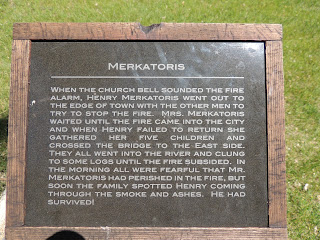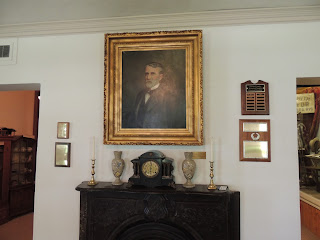June 19, 2016 We left Eagle River on Father's Day and headed to Oconto, WI. I was browsing the Travel Wisconsin book and saw what I thought would be interesting places to see. One was a mansion in Oconto that is now a museum that is open for tours, The other is a museum in Peshtigo documenting "America's most disastrous forest fire"
Even the people in Wisconsin don't seem to know that Oconto and Peshtigo exist, so here's a map. The marker is Oconto and just a few miles up Hwy 41 is Peshtigo.
Our campgrounds were located on the Oconto River and at one time it was the staging area for the Holt lumber Company. Logs would be brought here and stacked waiting to be loaded onto barges and taken out to Lake Michigan and points beyond. The land was donated to the city and it is now a city park and campground. Our site was right on the water.
These photos and depictions may not be great, but they are necessary to understand that this was a booming town.
This shows the church being moved across the bridge to it's present location to replace the lost church. It is now being used as the museum.
The building that the museum is in, is a church that was donated to the town and moved to the location of the original church destroyed by the fire. The cemetery next to the museum is where the folks who perished in the fire are buried.
There were very few artifacts recovered from the fire. One was the tabernacle from the Catholic church.
The other things in the museum were donated by families and are representative of times.
I've gone to many museums and have seen a lot of depressing things. The story of this town and how devastating this fire was, touched me in a way that only a few exhibits ever have. I will remember Peshtigo, WI.
On a lighter note, our next stop in back in Oconto to the Beyer Home Museum.
Built in 1868, it was the first brick house built in Oconto. It sits on an entire city block. George and Fannie Beyer bought it from the original owners in 1878 for $568.00 It was originally built in an Italianate style, but the Beyers remodeled it to be the Queen Anne style. Here's a drawing of the original house.
The Beyer's lost the house during the great depression and Oconto County took possession of it. The Historical Society has leased it from the county since 1940. It is decorated and furnished in the Victorian era decor.
An addition to the site opening this year is a carriage house that contains a vintage vehicle collection.
This car brought back memories of high school. A friends family owned one of these and it was really cool to ride around in it.
Also included in the annex are exhibits relating to the general history of Oconto County, including a reproduction of typical Main street storefronts.









































































No comments:
Post a Comment